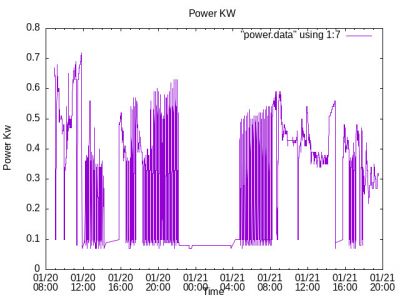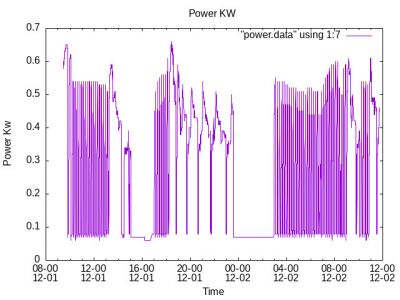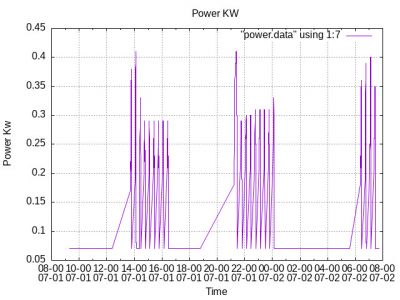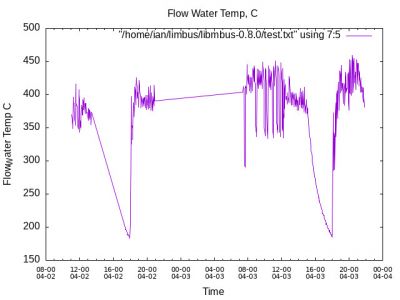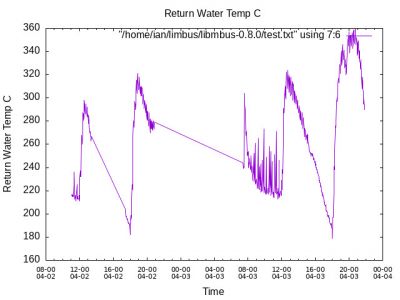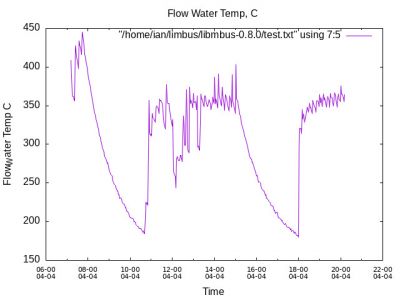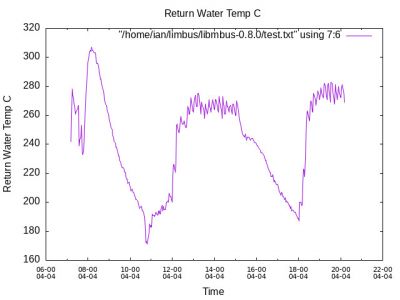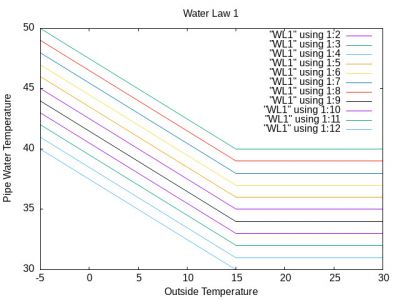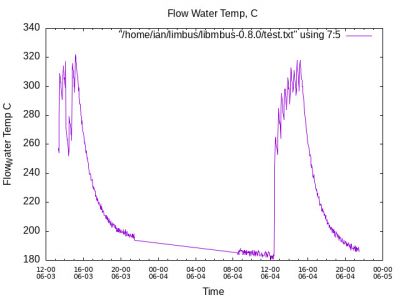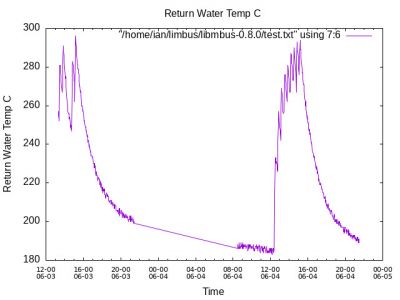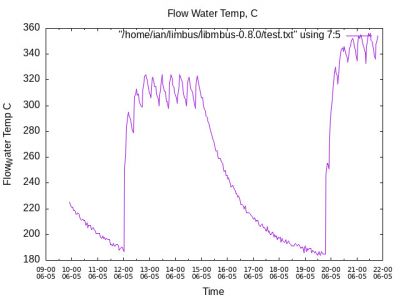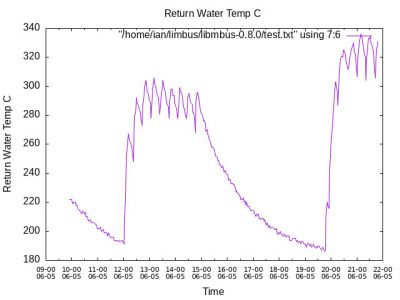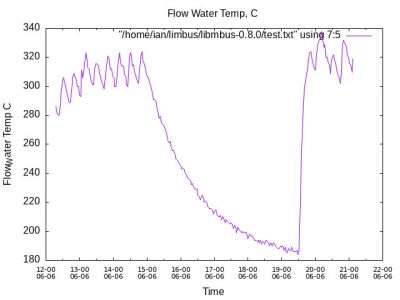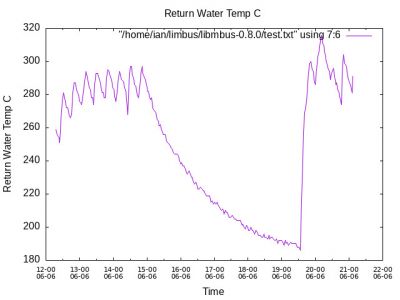I found this in the esi manual
' Chronoproportional control is a load compensator as it ensures that the boiler ‘ON’ time is reduced to a minimum and matches the boiler heat output with the heat loss. This reduces the net temperature of the return water to the boiler. This is due to the TPI (Time Proportional and Integral) advanced energy saving feature.'
It then goes on to say efficiency gains of 10% may occur because the reduced return temp means that the boiler will condense, whereas otherwise it would not.
So essentially it sounds like it is attempting to compensate for a boiler that is running at a flow temp which is too high (IE most UK boilers most of the time given that we don't use WC), and doing this by pwm of the boiler. I can't see this would help a heat pump at all (and am sceptical it will help a boiler).
Maybe I'm missing something (or maybe it's a load of technobabble)
4kW peak of solar PV since 2011; EV and a 1930s house which has been partially renovated to improve its efficiency. 7kW Vaillant heat pump.
@iantelescope the honeywell thermostat was initially designed to control fossil fuel boilers but is compatible with heatpumps.
If has the following cycle configurations:
3 cycles per hour for oil
6 cycles per hour for gas.
It is a form of pulse width modulation control which is used to control the temperature of the circulating water by varying the runtime of the boiler per cycle, having the affect of controlling the amount of heat energy pumped into a building.
Most fossil fuel boilers have a fixed or very limited power output range, so varying the runtime is the only way of changing the power output to match the heat loss of a building, ie the flow water temperature.
As heat pumps are capable of producing much lower flow temperatures it is easier to match the required flow temperature with the heat loss of the building, ie you can get the honeywell thermostat to demand heat near 100% of each cycle time if you have the ideal flow temperature matching the heat loss of the building so your heat pump practically runs all the time.
I know this is correct because I have ACTUALLY done it with my honeywell and samsung heatpump. I have repeated many times if you want to run your heat pump longer per cycle lower your flow temperature because the shorter thermostat runtime per cycle indicates too much energy is going into the building and it is trying average the heat power down with shorter running times thus lowering the flow water temperature to where it should be.
Regards
5 Bedroom House in Cambridgeshire, double glazing, 300mm loft insulation and cavity wall insulation
Design temperature 21C @ OAT -2C = 10.2Kw heat loss, deltaT = 8 degrees
Bivalent system containing:
12Kw Samsung High Temperature Quiet (Gen 6) heat pump
26Kw Grant Blue Flame Oil Boiler
4.1Kw Solar Panel Array
34Kwh GivEnergy Stackable Battery System
Posted by: @technogeek@iantelescope the honeywell thermostat was initially designed to control fossil fuel boilers but is compatible with heatpumps.
If has the following cycle configurations:
3 cycles per hour for oil
6 cycles per hour for gas.
It is a form of pulse width modulation control which is used to control the temperature of the circulating water by varying the runtime of the boiler per cycle, having the affect of controlling the amount of heat energy pumped into a building.
Most fossil fuel boilers have a fixed or very limited power output range, so varying the runtime is the only way of changing the power output to match the heat loss of a building, ie the flow water temperature.
As heat pumps are capable of producing much lower flow temperatures it is easier to match the required flow temperature with the heat loss of the building, ie you can get the honeywell thermostat to demand heat near 100% of each cycle time if you have the ideal flow temperature matching the heat loss of the building so your heat pump practically runs all the time.
I know this is correct because I have ACTUALLY done it with my honeywell and samsung heatpump. I have repeated many times if you want to run your heat pump longer per cycle lower your flow temperature because the shorter thermostat runtime per cycle indicates too much energy is going into the building and it is trying average the heat power down with shorter running times thus lowering the flow water temperature to where it should be.
Regards
I don't wish to get into an argument here but varying the flow temperature is exactly what weather compensation is designed to do. WC is built into all heat pumps and many boilers. Its not generally enabled for boilers in the UK, for reasons that are not really sensible, but should be enabled for heat pumps. I don't doubt it is possible to get an external controller to simulate the weather compensation function built into a heat pump by the heat pump manufacturer, but it shouldn't be the first port of call.
Of course if the heat pump is oversized then time modulation is the only option left once weather compensation has been enabled and set up correctly and the heat pump has turned down to its minimum output value. Whether its better to use the heat pumps own time modulation function (adjusting the minimum cycle time if you wish) or an external time modulator is certainly a valid question, although in general occams razor is a good principle to apply. Alternatively you can just go the whole hog and batch heat evening and morning, relying on the thermal mass of the building to carry you through. This is likely to be way more efficient than frequent on/off switching by an external controller and, depending on the house construction no less comfortable.
It is certainly a very BAD idea to have weather compensation set up poorly, and rely on the PWM control to match the output, because it means that the heat pump is running (when it is running) at a higher flow temperature than it needs to, which compromises efficiency. I dont think you are suggesting this because you also say 'As heat pumps are capable of producing much lower flow temperatures it is easier to match the required flow temperature with the heat loss of the building, ie you can get the honeywell thermostat to demand heat near 100% of each cycle time if you have the ideal flow temperature matching the heat loss of the building so your heat pump practically runs all the time.', but it would be all to easy to rely on the thermostat to do the job not the heat pump controller and a properly adjusted WC curve.
4kW peak of solar PV since 2011; EV and a 1930s house which has been partially renovated to improve its efficiency. 7kW Vaillant heat pump.
Posted by: @jamespaI don't wish to get into an argument here but varying the flow temperature is exactly what weather compensation is designed to do. WC is built into all heat pumps and many boilers. Its not generally enabled for boilers in the UK, for reasons that are not really sensible, but should be enabled for heat pumps. I don't doubt it is possible to get an external controller to simulate the weather compensation function built into a heat pump by the heat pump manufacturer, but it shouldn't be the first port of call.
You are absolutely correct and my point exactly. By using the correctly configured heat pump weather compensation you can match the heat source output to the heat load across the entire external temperature operating range. By balancing the heat input to heat loss of the house the thermostat can practically call for heat near 100% of the time thus running the heat pump continuously.
This cannot be done with an oil boiler for example because they have a fixed output so the only way this type of thermostat can vary the water temperature is by varying the running time of the oil boiler and hence the temperature of the water, ie short runs = cool water, long runs = hotter water.
Regards
5 Bedroom House in Cambridgeshire, double glazing, 300mm loft insulation and cavity wall insulation
Design temperature 21C @ OAT -2C = 10.2Kw heat loss, deltaT = 8 degrees
Bivalent system containing:
12Kw Samsung High Temperature Quiet (Gen 6) heat pump
26Kw Grant Blue Flame Oil Boiler
4.1Kw Solar Panel Array
34Kwh GivEnergy Stackable Battery System
Should I leave Power control to ONE Controller, the Samsung Weather Compensation System ?
Given that the Honeywell was designed for use on Boilers should I continue to use the Honeywell on my Heat Pump?
What is, or should be, controlling the Power of my Heat Pump?
Should I leave Power control to ONE Controller, the Samsung Weather Compensation System ?
1) Should The Honeywell Home variable Run Time Room Thermostat have any say , or Control over Heat Pump Power?
OR
2) Should The Samsung "Weather Compensation Thermostat", controlled, ultimately, by the external, outside Temperature Sensor using a Continuous INVERTER Power control be granted SOLE Control over Heat Pump Power.
OR
3) Should The ON OFF "Short Cycling" experienced when the Power demanded of the Heat Pump is less than the Minimum INVERTER Power. have some control?
Should I leave Power control to ONE Controller, the Samsung Weather Compensation System ?
Switching Power Noise Performance :
This was the behaviour of my Heat Pump on 20-21 st Jan 2023 and 01-12-2023
Present Switching Power Performance:
This was the Heat Pump Power Consumption on 1-7-2024:
Notice the reduction in Power Switching, following the reduction in Cycle Frequency as set by the Honeywell Thermostat.
Conclusion: Increasing the Cycle Period to 20 minutes has reduced the excessive power switching.
Would a further increase in Cycle period further reduce power switching?
Given that the Honeywell was designed for use on Boilers should I continue to use the Honeywell on my Heat Pump?
I cannot reduce the Water Flow Temperature to increase the Honeywell Run time pulse width!
My Samsung Heat Pump is already producing Flow Water Pipe Temperatures of between 28 C and 35 C:
My System was "Designed" to supply Flow Water Temperatures FROM 35 C up to 55 C !
The Temperatures were measured using a , probably accurate, "Sharky" IN- Water Power meter attached to the start of the Radiator circuit.
The Samsung Weather compensation Offset Temperature was 2.5 C on a Water Law Curve coordinate of 45 C at an ordinate of -5 C.
I cannot, therefore, further reduce the Water Flow Temperature to increase the Honeywell Run time pulse width!
I cannot , therefore, further reduce the Water Flow Temperature to increase the system efficiency !
I cannot, therefore, further reduce the Water Flow Temperature to install an IN SERIES Buffer tank!
@iantelescope you cannot sort your control system out until you have sorted your hydraulic issues out and you are happy that it is running as efficiently as possible.
From my perspective it seems too many solutions have been suggested that resolve the symptoms not the real issue.
Let me give an example of what I mean:
You switch all your radiators off and what will happen?
1. The thermostat starts to continuously demand heat because your house is getting colder and colder.
2. Your heat pump is running continuously because the thermostat is telling it to, but your radiators are off so it has nowhere to get rid of the heat it is generating so short cycles!
Then some "bright spark" comes along and tells you "if your heat pump is short cycling then you need a buffer to make the heat pump think its driving a bigger system".
Great you say, you put one in and it resolves the issue for a short while until the heat store (buffer) has reached a certain temperature (because it does not emit heat) and your original issue returns, however your house is still cold!
So you attempted to resolve the symptom of short cycling with the buffer tank but if the correct investigation and understanding of the issue was done the real solution to the problem was to switch the radiators on
So my point is until you are totally happy that the radiators are correctly balanced, you have set the correct flow rate in your secondary circuit to deliver the correct volume of heat for your heat loss calculations, your heat transfer across your heat exchanger is as efficient as possible then you are seriously going to struggle to match the heat pump output to the heat loss of your house. Until the heat pump can deliver all the heat it generates to your emitters ie your radiators, it will always cycle
Regards
5 Bedroom House in Cambridgeshire, double glazing, 300mm loft insulation and cavity wall insulation
Design temperature 21C @ OAT -2C = 10.2Kw heat loss, deltaT = 8 degrees
Bivalent system containing:
12Kw Samsung High Temperature Quiet (Gen 6) heat pump
26Kw Grant Blue Flame Oil Boiler
4.1Kw Solar Panel Array
34Kwh GivEnergy Stackable Battery System
@ technogeek Quote "So my point is until you are totally happy that the radiators are correctly balanced,"
How do I balance a system with flow and return water temperatures below the minimum "Designed" Flow Water Temperature of 35 C :
All measured by a "Sharky In-Water " Power Meter at the start of the Radiator circuit.
with Radiator Water Temperatures often lower at between 28 and 37 C.
Unfortunately, I cannot store the claimed Water Temperatures of ~39 to 42 C displayed on the LCD Samsung control panel.
I have tried increasing the Weather Compensation Offset to +5 along with the Water law graph to [55 ,-5] .
With the Honeywell now operating on a 20 minute Cycle time I will now repeat increasing the Weather Compensation Offset to +5 along with the Water law graph to [55 ,-5] .
Many thanks.
During colder weather conditions your heat pump should be controlled by the heat pump controller using WC. The room thermostat should merely be on calling for heat and therefore enabling the heat pump to run.
Your present Honeywell room thermostat would be calling for heating most of the time, but within the presently set 20 minute cycle period could switch the heat pump off for several minutes. This is why a basic on/off type thermostat would probably be a better option, and should have a temperature setting 1C or 2C above the desired room temperature. Can the Honeywell be set to operate as a basic thermostat?
As TechnoGeek has pointed out, all the radiators need to be in circuit, and there needs to be an adequate water flow rate in both the primary and secondary water circuits. Your graphs should then show a fairly constant LWT that varies with heating demand as OAT varies. It should then be possible to adjust the WC curve such that it maintains the desired IAT.
During milder weather conditions the WC should lower the LWT to reduce the thermal energy output from the heat pump, which it does by reducing the speed of the compressor. This works fine until the compressor reaches minimum speed and cannot go any lower. The heat pump will still continue to operate but will be producing more thermal energy than is required to heat your home. The net effect is that the LWT and RWT will start to increase, which in turn will increase the IAT, until the LWT or RWT reaches an upper limit or the room thermostat reaches its setting and switches off. Either of these conditions will stop the compressor.
With the compressor stopped LWT, RWT and IAT will start to fall. If the compressor was stopped due to LWT or RWT reaching its upper limit, then it will restart once the lower limit has been reached. If the compressor was stopped by the room thermostat then it will not restart until the room thermostat resets.
The heat pump will now be cycling, but the frequency will be determined by temperature variations and not by the preset cycling of the Honeywell thermostat.
Posted by: @iantelescopeHow do I balance a system with flow and return water temperatures below the minimum "Designed" Flow Water Temperature of 35 C :
The method I used was as follows but it was done in Autumn and partial Winter when the heat demand was higher, in mid Summer this could be very tricky!
1. Using a thermometer with differential pipe clamps I measured the temperature drop across each radiator and adjusted the lock shield valve to get an approximate 5 Celsius difference.
2. Using thermometers with historical logging (Govee's) placed in different rooms, I checked the temperature over a 24 - 48 hour period for each room to see if the room was approximately the same temperature as the lounge, in my case 21 Celsius. I would then do slight adjustments to increase or decrease the temperature, eventually having an even temperature throughout the house.
3. After establishing the minimum required flow rate for my heat pump, which is a 12Kw Samsung, Samsung state it to be a minimum of 34 litres/minute, I checked the flow rate to see if this was ok ( is actually 38 litres / minute ). If my memory serves me correct you have a 5Kw unit so I would hazard a guess your flow rate will be approximately 16 -17 litres / minute minimum but you need to check this.
To help keep the flow rate above 34 litres / minute I have a pressure differential bypass valve connected across the radiator circuit, set to open at a particular pump head pressure. This only operates if any radiators partially close down or shut off however as they are all balanced and on all the time, this never happens.
In your case the only possible way of getting sufficiently hot flow is to temporarily fix your heat pump output to say 45 - 50 Celsius (disable WC) and your thermostat set to 30 Celsius to demand heat 100% of the time while you do the measuring and adjustments. You will also need to isolate the buffer tank in the primary circuit if you have not done already. Once you have the radiators balanced you can re-enable your weather compensation.
Someone else may have a better suggestion but the above method was the one I used.
There are other methods to balancing radiators described by HeatGeeks and Toodles wrote a very good article recently. It depends what tools and equipment you have to hand as to which method you use.
Regards
5 Bedroom House in Cambridgeshire, double glazing, 300mm loft insulation and cavity wall insulation
Design temperature 21C @ OAT -2C = 10.2Kw heat loss, deltaT = 8 degrees
Bivalent system containing:
12Kw Samsung High Temperature Quiet (Gen 6) heat pump
26Kw Grant Blue Flame Oil Boiler
4.1Kw Solar Panel Array
34Kwh GivEnergy Stackable Battery System
A Control Tautology?
Should my Heat Pump Cycle Time be Simultaneously controlled by my Honeywell Home Thermostat AND by my Heat Pump Cycle time control?.
@derek-m ........No Derek, My Honeywell Home Thermostat cannot operate as a simple ON-OFF Thermostat.
Operating in simple ON-OFF mode would remove the clash between the Cycle Time set by the Thermostat AND the Cycle Time set by the Heat Pump itself…
Again , an excellent , concise explanation of how to Balance Radiators.
With Two years experience I have accumulated innumerable Sensors , Meters etc etc.
I will take your advice and try Balancing without Weather Control , Buffer tank et al.
- 26 Forums
- 2,426 Topics
- 55.1 K Posts
- 201 Online
- 6,104 Members
Join Us!
Worth Watching
Latest Posts
-
RE: Is it normal to use power from the grid when running off the battery?
@batpred I may be asking you for more info in how you h...
By JohnnyB , 2 hours ago
-
RE: Recommended home battery inverters + regulatory matters - help requested
@johnnyb The noise of the Solis is nothing very sign...
By Batpred , 2 hours ago
-
RE: Is my Samsung gen6 outside air temp sensor missing a sheath/sleeve?
@papahuhu Yes, good information is often hard to find, ...
By Old_Scientist , 2 hours ago
-
RE: R290 and Foundation Air Bricks
Professional risk assessment (inc some common sense) ...
By ASHP-BOBBA , 3 hours ago
-

RE: The good, the bad and the not that great – my heat pump installation
@toodles ahhh no trouble yeah probably won't mess with ...
By Burtis , 3 hours ago
-
RE: Daikin Wireless Thermostat
@bash we have mostly south facing rooms which would ove...
By Judith , 4 hours ago
-

RE: Post-Traumatic Heat Pump Stress Disorder
Some more examples of those that really should be benef...
By Jeff , 5 hours ago
-
RE: Installer Fitted 9kW Instead of 11kW Heat Pump and Changed MCS Paperwork - What do I do?
I've now had an interesting email from a Complaints Res...
By MairiA , 7 hours ago
-

RE: Reliable, easy to use home battery options
Correct. LiFePO₄ cells mustn't be charged if their te...
By Transparent , 7 hours ago
-

RE: Water outage in the the south-east
Indeed!Any contamination in the well water would be tra...
By Transparent , 9 hours ago
-
RE: Solis inverters S6-EH1P: pros and cons and battery options
I hear some cases of apparent misconfiguration of inver...
By Batpred , 9 hours ago
-
Are split ASHPs with R290 refrigerant coming soon?
Question. Are there any (or likely to be in the near t...
By iotum , 12 hours ago
-

RE: Setback savings - fact or fiction?
Indeed. In many ways, a defrost is a setback, with the ...
By cathodeRay , 12 hours ago
-
RE: Heat pump not reaching flow temperature
The good news is that it leaves no excuse if it doesn't...
By JamesPa , 12 hours ago
-
RE: How to use my Hanchu battery storage for home without it feeding back into the grid?
@countryman-helmsley In that case is there a button ...
By IRMartini , 12 hours ago
-
RE: Ideal HP290 14kW ASHP - how to optimise
Great. It’s not bad is it, though I agree it may repres...
By Davesoa , 14 hours ago
-
RE: Ecodan Pump Issues… Circulation pump turns off when heat pump compressor turns off
@f1p apologies, you are absolutely correct
By Patch321 , 14 hours ago
-

RE: Samsung E101 Error Message and my ASHP Efficiency
@johnnyb amazing that the our forum is serving its purp...
By Mars , 1 day ago
-
Best option for controller upgrade? - Grant Aerona
Fairly new heat pump owner - Grant Aerona 3 10kw - and ...
By Topher , 1 day ago
-

Just a brief update to keep things transparent. Secti...
By DREI , 1 day ago

